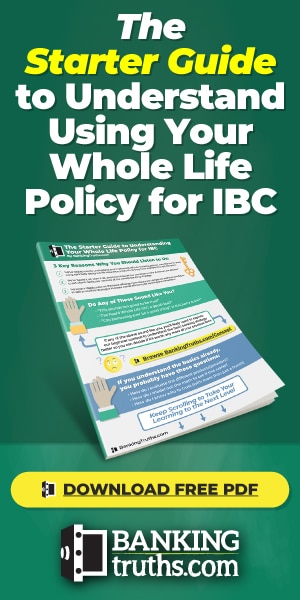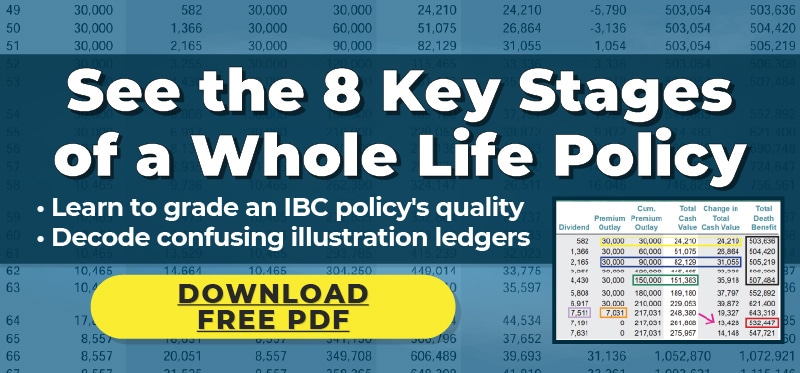Whole Life’s Riders and Growth Components Explained
Whole Life’s Riders & Growth Components Explained
Ever been confused by exactly how whole life works? Not to mention all the different riders needed to transform an ordinary old whole life policy to act as your own private bank or retirement vehicle.
Well my apologies in advance to any car enthusiasts out there as I use this race car analogy to explain the interplay between the different components of a whole life policy along with the various riders bolted on when optimizing for cash value performance
For those of you who don’t know me yet, I’m John Hutchinson – effectually known as Hutch. And my site BankingTruths.com has loads of articles and videos on how to re-engineer and optimize life insurance policies for wealth building.
Most people researching whole life soon learned that in addition to the growth that’s guaranteed inside your base whole life policy, there are also dividends, a paid-up additions rider, a term insurance rider, and of course none of this works without your premium dollars or a mutual life insurance company to put these premiums to work.
Let’s drill deeper into these different parts of the vehicle. It all starts with this dark gray, heavy engine block – your base whole life policy. This is the core nucleus of performance which all the other components revolve around. Some of the other aspects of a whole life policy or riders may seem more appealing to you. But none can exist without the integral structure of your base policy.
This other shiny silver souped-up engine over here is your paid-up additions rider. Sure, your whole life vehicle can move without this bolted on addition, but it won’t be moving very fast. On the other hand, if you design your car with only a standalone paid-up additions rider or stack too much of this rider onto your car you will essentially be disqualified from certain races – mainly the races dealing with favorable taxation.
Now there is a workaround if you want to add a disproportionate amount of paid-up additions rider bolted onto a small base policy. Going back to our car analogy, you’ll need more overall support from the chassis in the form of a death benefit to support the added performance components.
This can be accomplished two ways – by adding more bulky base policy with its heavy metal support or you can add in a streamlined titanium chassis in the form of a term rider to accommodate a lopsided amount of paid-up additions. Since the term rider provides this extra death benefit for a fraction of the cost than adding more base policy would, we’ve represented here as the lighter shinier silver titanium chassis versus the dark gray heavy metal that come stock with the base policy.
To be clear, the term rider or streamlined chassis itself is not a performance factor other than the fact that it provides the necessary support for more high performing PUAs without the extra drag from adding more heavy base policy.
Let’s talk about dividends. Since they are not guaranteed and both a base whole life policy and a PUA Rider can function without dividends it’s best to describe them as a special additive. This is especially true since the exact amount of dividends you’ll receive will fluctuate regularly throughout the life of your policy.
It’s no accident that there are three different colored beakers represented here because a dividend is made up of three distinct components. The interest component based on what your mutual insurance company earns on its entire portfolio of investments that year, the company’s actual mortality experience that year versus what was originally projected when underwriting that particular block of business, and last how well the mutual company is managing its operational expenses.
It’s also worth noting that these additives get measured and dispensed by your pit crew or the mutual insurance company you choose. Since your policy will come into a pit stop for this extra juice every single year, both the quantity and the quality of these additives will vary depending on how good your pit crew is. You want a crew with both a solid historical track record as well as stellar recent results since their additives will enhance the performance of both the base policy and the PUA Rider.
The bigger the engine you’ve built the more dividend additives your car will be entitled to, assuming that you’ve also been putting the necessary fuel or premiums in along the way. I’m showing two cans of fuel because some of it goes to the base policy which will be burned much less efficiently in the short run but still yield respectable long term results on its own and some of your premium fuel will be devoted entirely to the PUA Rider where it boosts both immediate acceleration and long term performance.
Hopefully whatever liberties I took with the racing industry didn’t annoy too many people. And more importantly that they helped you better understand what’s under the hood of a properly structured whole life insurance policy designed for banking and retirement.
Before we look at some examples of how differently structured whole life cars can perform, let me just clarify that we’re assuming here that maximum cash accumulation is a goal rather than permanent death benefit. We’ll be using policy specs for a 46-year-old male with only a standard rating – that’s two down from preferred best. And this policy is from the low dividend rate environment of 2019.
The numbers you’re about to see are for conceptual learning only and that your particular policy specs and the general performance of whole life may be substantially different depending on when exactly you’re watching this video.
What we have here is the exact same size-based policy only as we move from left to right, we’re adding more and more of the components we just learned about onto our whole life racecar.
Starting on the left, this is your stock ordinary base whole life policy without any special riders. Starting in year four, you can tell this particular policy starts receiving dividends because a death benefit starts increasing. This is because we’ve elected to have the dividends go to buy paid-up additions or PUAs which will enhance the performance of both the cash value and the death benefit.
To be clear though this car has no PUA Rider, allowing you to add fuel that goes straight towards increasing torque from paid up additions. But even with the base whole life policy, you can elect to have your dividend additives be converted to PUAs within your policy and they do compound your overall performance only at a very slow acceleration rate.
You may have read that whole life insurance is a bad investment because it takes around 14 years to break even. Well, what they’re talking about is just a base policy all by itself and that’s what you’re looking at right here. However, it is worth noting that even after those early negative years the sum of all your premiums actually do wind up getting a total positive return. And actually, once the long and slow acceleration with that heavy engine block kicks in, the later years start accelerating very nicely and even make up for the slow ramping up period.
All right. Let’s upgrade our vehicle now to a base policy with a maxed out paid-up additions rider without the addition of any term rider. Right out of the gate you can see from the premium numbers that the added torque of that shiny silver PUA Rider requires significantly more fuel – more than double the base premium actually.
The normal heavy metal chassis of the base whole life policy is all that’s needed to support up to this size of a paid-up additions rider without any term rider. That extra fuel seems to be worth it from the obvious boost to performance. You can see that our break-even crossover happens in year 9 by maxing out PUA rather than in year 14 like with our base policy only.
And the 20-year cash value and IRR or internal rate of return numbers seem to be a bit more attractive across the board. You can see too that the death benefit starts increasing rapidly right out of the gate due to the instant premium going to paid-up additions which are really like stacking little mini whole life policies right on to our base policy. Only the PUAs are completely paid up with one shot.
Let’s kick it up another notch by adding even more PUA Riders supported by the added titanium chassis of a term rider. You can see that our death benefit starts out now at five hundred thousand rather than the hundred sixty-six thousand of just our base policy.
Now if that five hundred-thousand-dollar death benefit was manufactured with all base policy and no term rider, sure we could add the extra premium fuel but a big portion of it would go towards that bulky gray growth engine supported by the heavier chassis. And you saw what kind of acceleration that produced.
Instead by creating the necessary death benefits support using the lightweight titanium chassis of the term rider, we can add a disproportionate amount of PUA Rider premium. Remember our original base premium was just over thirty-five hundred dollars a year and now we could add over eighty-five hundred of additional fuel most of which will go straight to instant performance from the paid-up additions rider.
This brings our cash on cash break-even point down to Year 7 and you can even see down here that by funding a policy this hard and early almost your entire 30-year premium shows up in cash value. Once this happens we like to say that going forward you’re like moving money from one pocket to another pocket.
Now once we’re able to engineer this kind of performance out of whole life it usually becomes attractive enough for people to start using it as their own bank and retirement vehicle especially as our forty-six-year-old stops paying premiums during retirement.
You can see how these performance figures just keep getting better and better with no further premiums past the 20th year. And remember this illustration assumes we see static with 2019 low dividend rate. If interest rates and dividends increase this policy can actually be much better than what you’re seeing here.
Now this car may be designed optimally but it’s not fueled optimally. Let me show you the next level of whole life insurance performance that I found very few clients ever even see from their agents.
We just flip this comparison around so that the souped-up race car you just saw with the term rider allowing for $12000 of premiums for 20 straight years is now over here on your left. What you’re seeing in the middle is actually the exact same policy by design, but most people don’t realize that the titanium term chassis allows you to double stack your PDA riders at least in the shorter term sprint like races.
Now what I mean by that is you can enhance performance even further by putting in nearly twice as much premium but for a shorter period of time. You can continue to fuel your car for 20 years but you’re front loading it for maximum performance both earlier and later. That extra early fuel throughout the first eight years creates a massive amount of momentum that translate to better performance across the board.
You can clearly see that our overall internal rate of return for the first nine years is higher by a staggering point and a half. Our break-even hits by year five and by year three we’re well into the black on all new premium dollars. Not to mention the negative returns that come in the first couple of years have been substantially mitigated by creating this early momentum.
Even our ongoing death benefit has had much larger increases because of all the PUAs stacking. All this extra death benefit is shed of mortality costs past the first year because as its namesake suggests a paid-up addition is bought and paid for without one initial premium. From then on, it’s pure growth.
Now right next to this front-loaded beast of a car is the exact same vehicle only with inconsistent fuel or premium amounts added over the years. Let’s face it – life is uncertain and finances fluctuate. This scenario shows someone who started out with the intention of funding to the maximum but couldn’t do so after the second year.
We have them paying just the minimum base premium in years 3 and 4 but actually, they have so much cash value that they could easily borrow against it to pay this based premium if necessary.
Still, by paying even just the base premium the cash value increases nicely in years 3 and 4 by considerably more than the premiums paid in year five. They’re paying a premium that would have violated the mech limits if done earlier but since the driver previously skipped the opportunity to fully fuel the PUA Rider they’re temporarily allowed increased capacity to catch it up to some degree.
In year six they go back to paying the previous maximum and then from year 7 through nine just paying the bare minimum, and again in year 10 paying the initial maximum allowable premium. In five out of the first ten years, nothing but the bare minimum base premium was paid and still when we compare the IRR with the front-loaded optimal policy we’re not really that far behind.
We’re talking 30 basis points difference and even less so by year 20. Only 13 basis points of separation where less money went in and much later at that. If we get all the way out to year 40 there’s only six basis points difference and that’s without doing any kind of allowable death benefit reduction to maximize cash value growth.
Remember too that this policy doesn’t even have a preferred rating. What does this tell us – that there’s nothing wrong with building yourself a big car even if you can’t keep feeling it to the absolute maximum throughout the policy.
Last we’re going to look at a scenario where someone wants the big car but can’t quite front-loaded with all the fuel right away. For comparison’s sake we put the optimal front load of policy to the far left, the flexible premium scenario we just looked at in the center, and this new ramping up scenario over here to the right.
Remember all of these are the exact same base policy in combination of riders. Notice for the first couple of years from an IRR standpoint this policy is way behind the other flexible scenario but by Year 6, it’s exactly the same – even though less total premium dollars went in.
By year 10 it pulls ahead by as much as 10 basis points and stays ahead in spite of putting in less total premiums. When we compare both of these flexibly funded premium scenarios to the front-loaded optimal policy neither are ever that far behind.
So again, you’re best off building a car big enough for whatever kind of maximum premiums you’ll eventually be able to fuel it with, even if you can’t start those premiums right away or you can’t sustain them every year. And of course, with either of these designs you need to pick a mutual company that allows for a wide range of flexibility with the PUA Rider funding. Some mandate that you must do your maximum possible over-funding in the very first year and some companies have a use it or lose it provision after not doing the maximum after a year or a certain number of years.
Hopefully, this video helped you to better understand how whole life works with the different riders and funding levels. Remember it’s better the younger and healthier you start it so grab a spot on our calendar so we can show you the optimal product specs for you.

John “Hutch” Hutchinson, ChFC®, CLU®, AEP®, EA
Founder of BankingTruths.com




